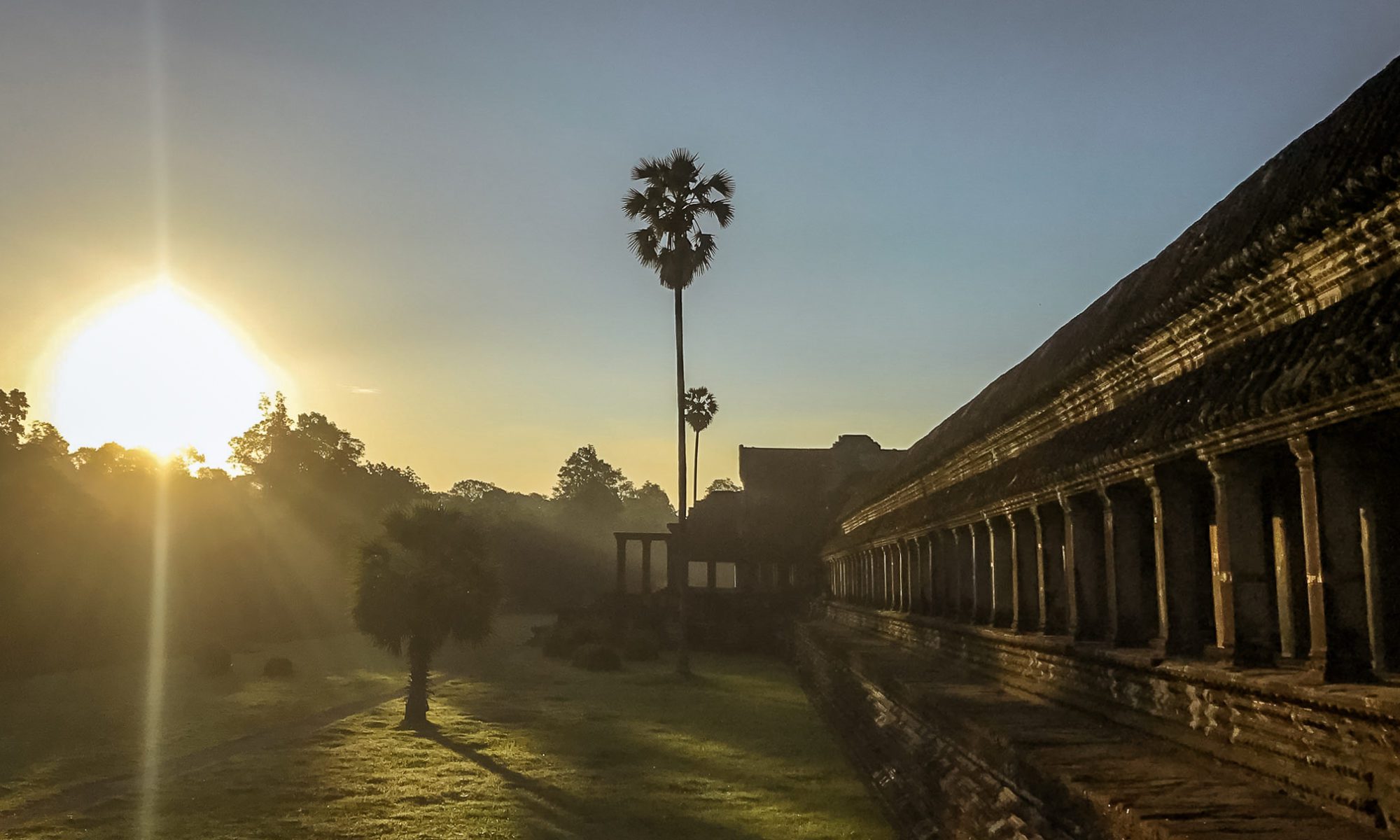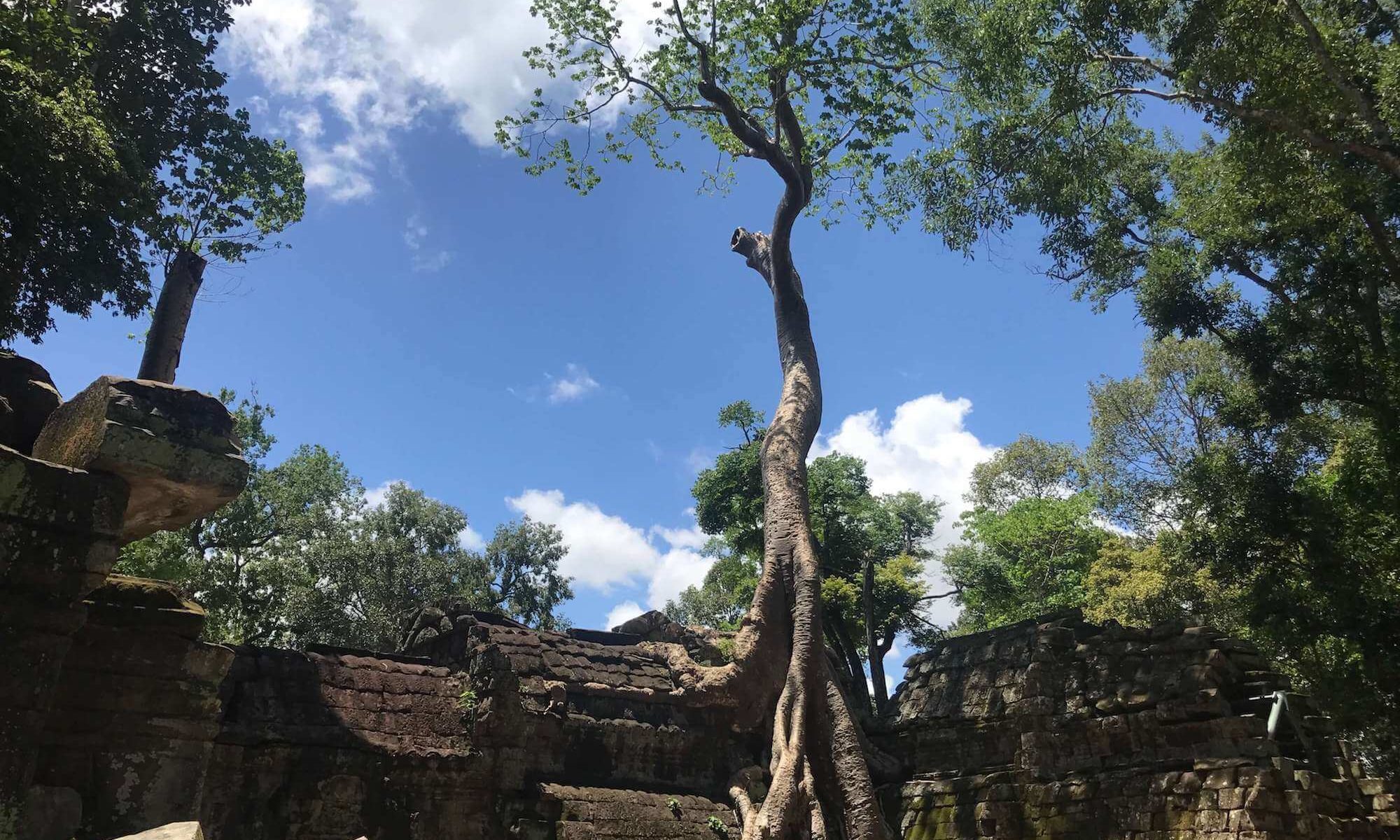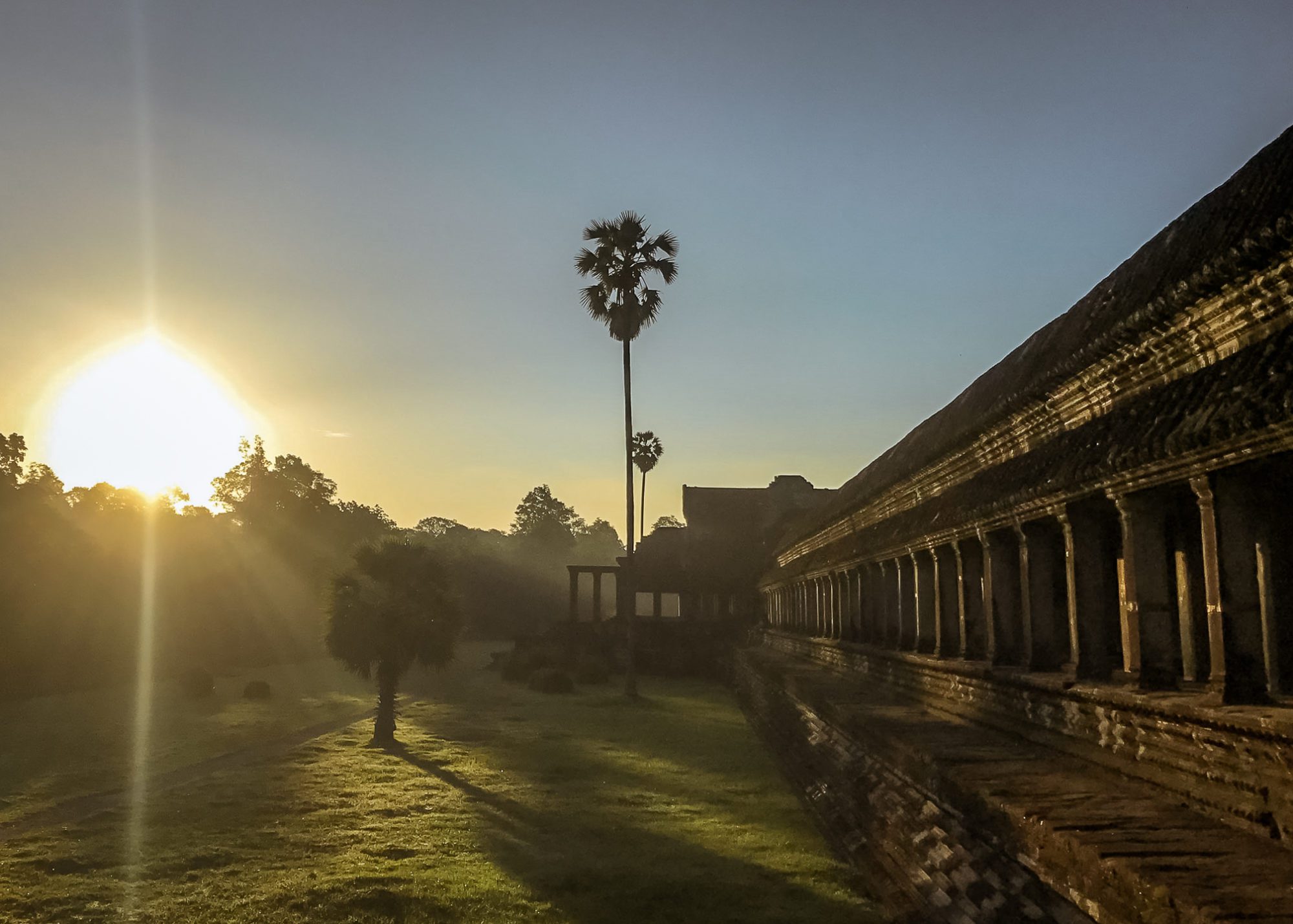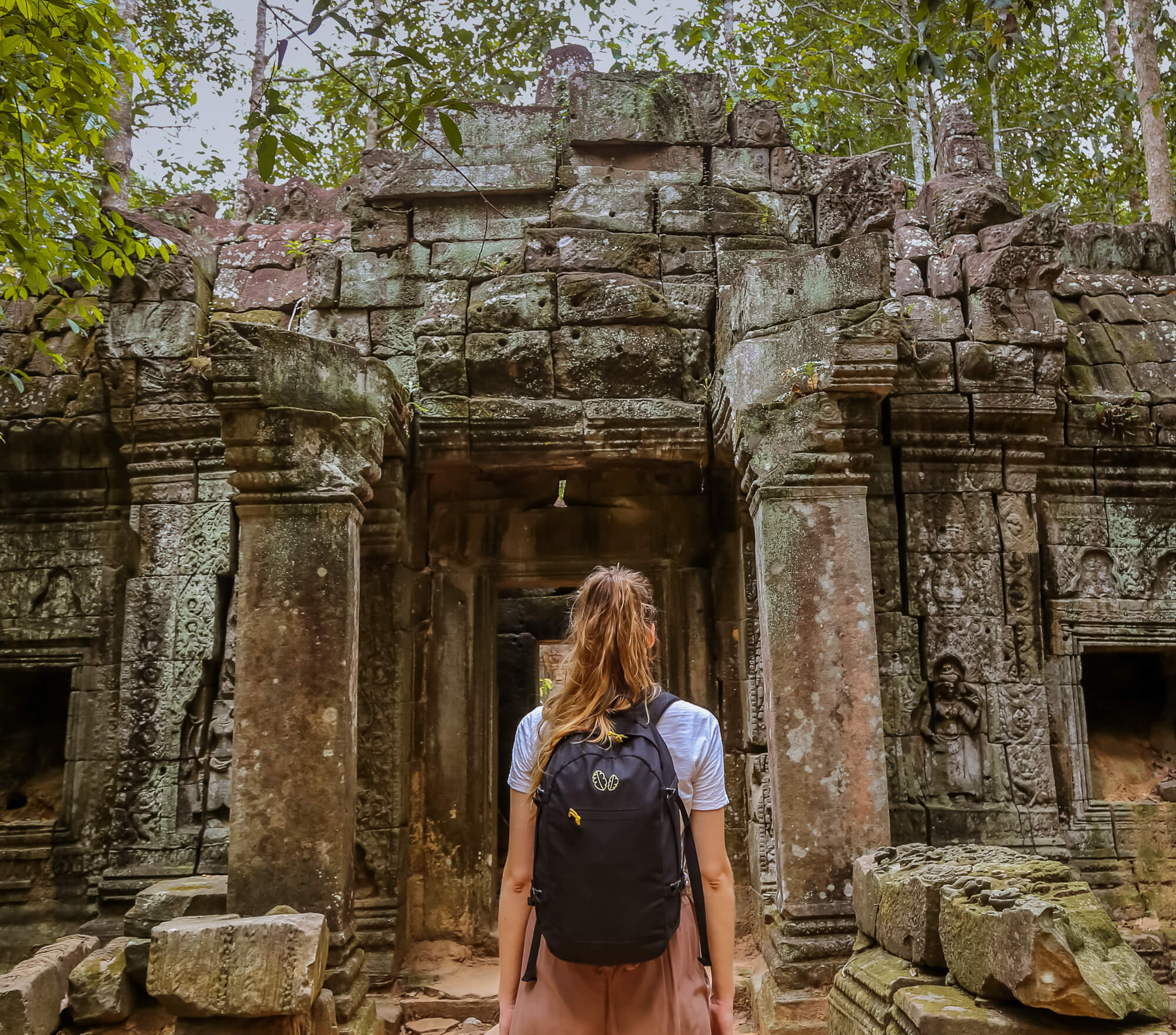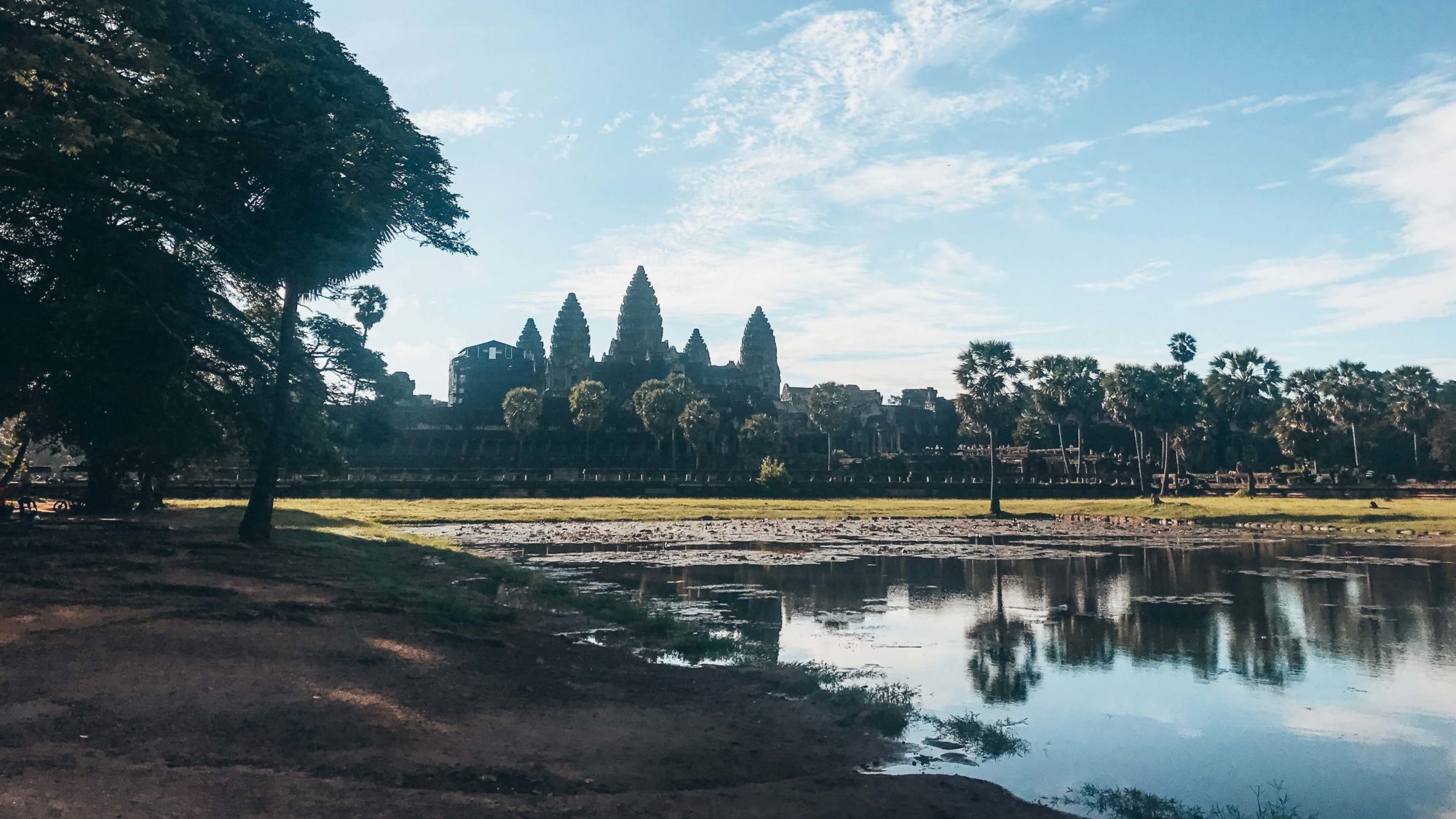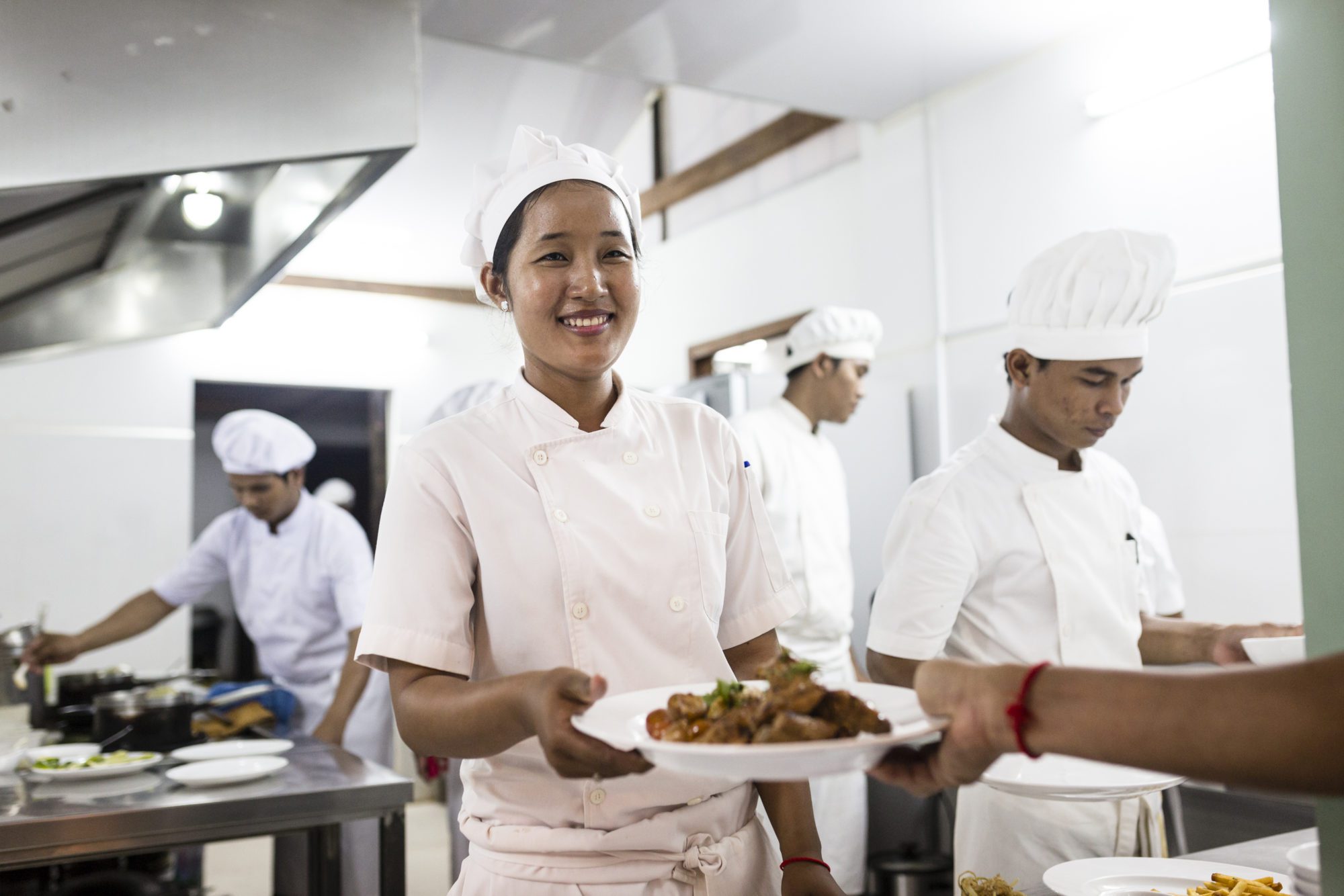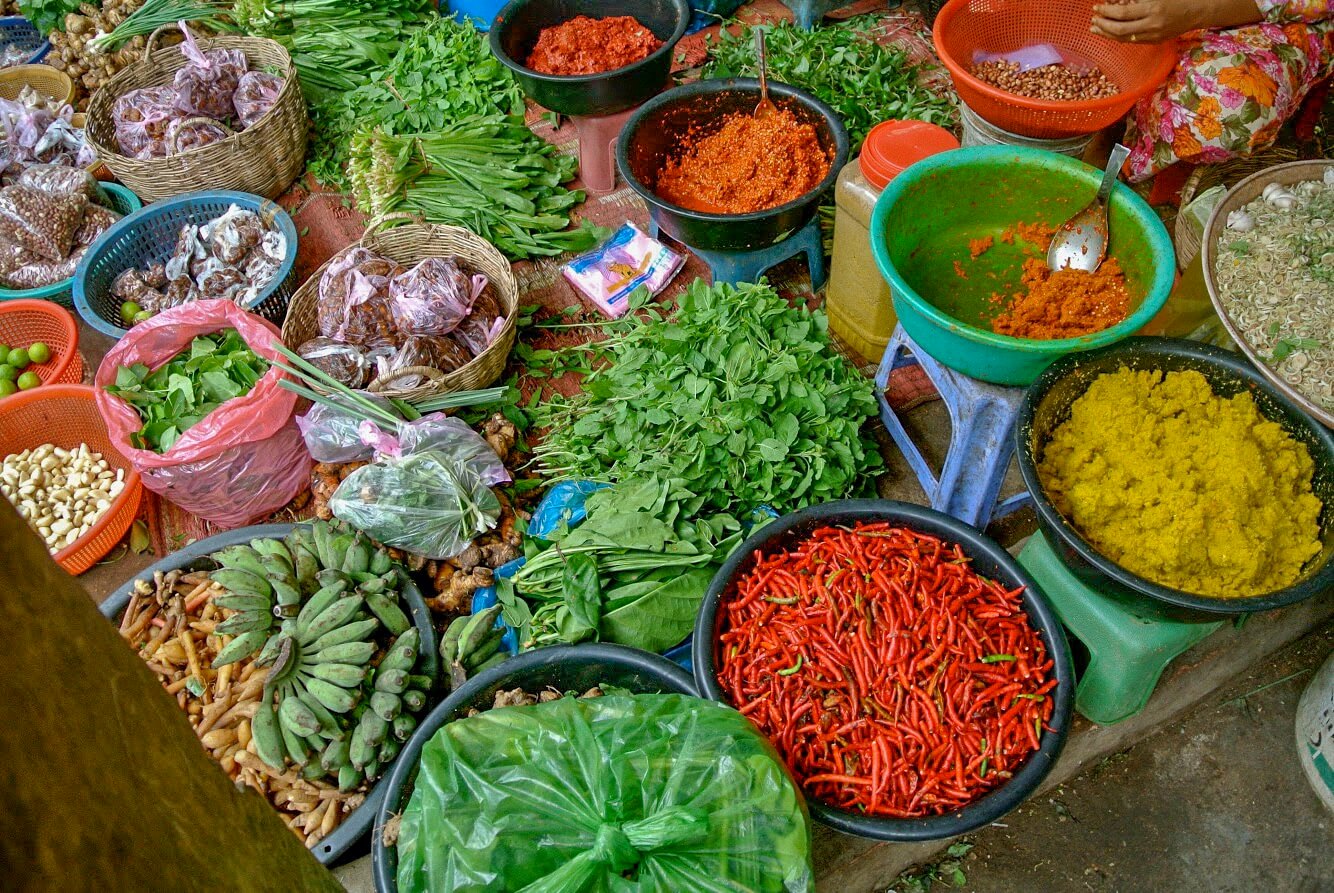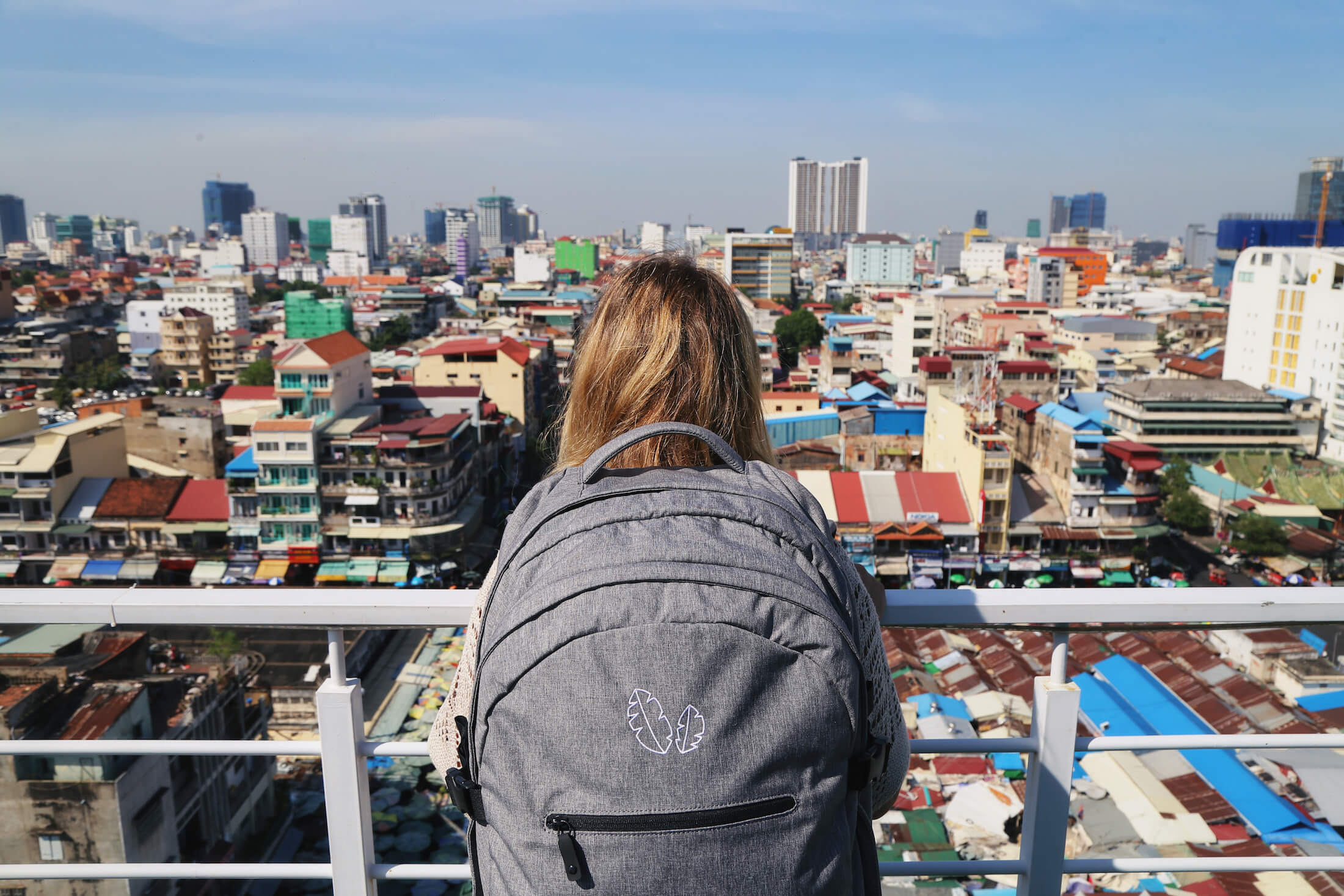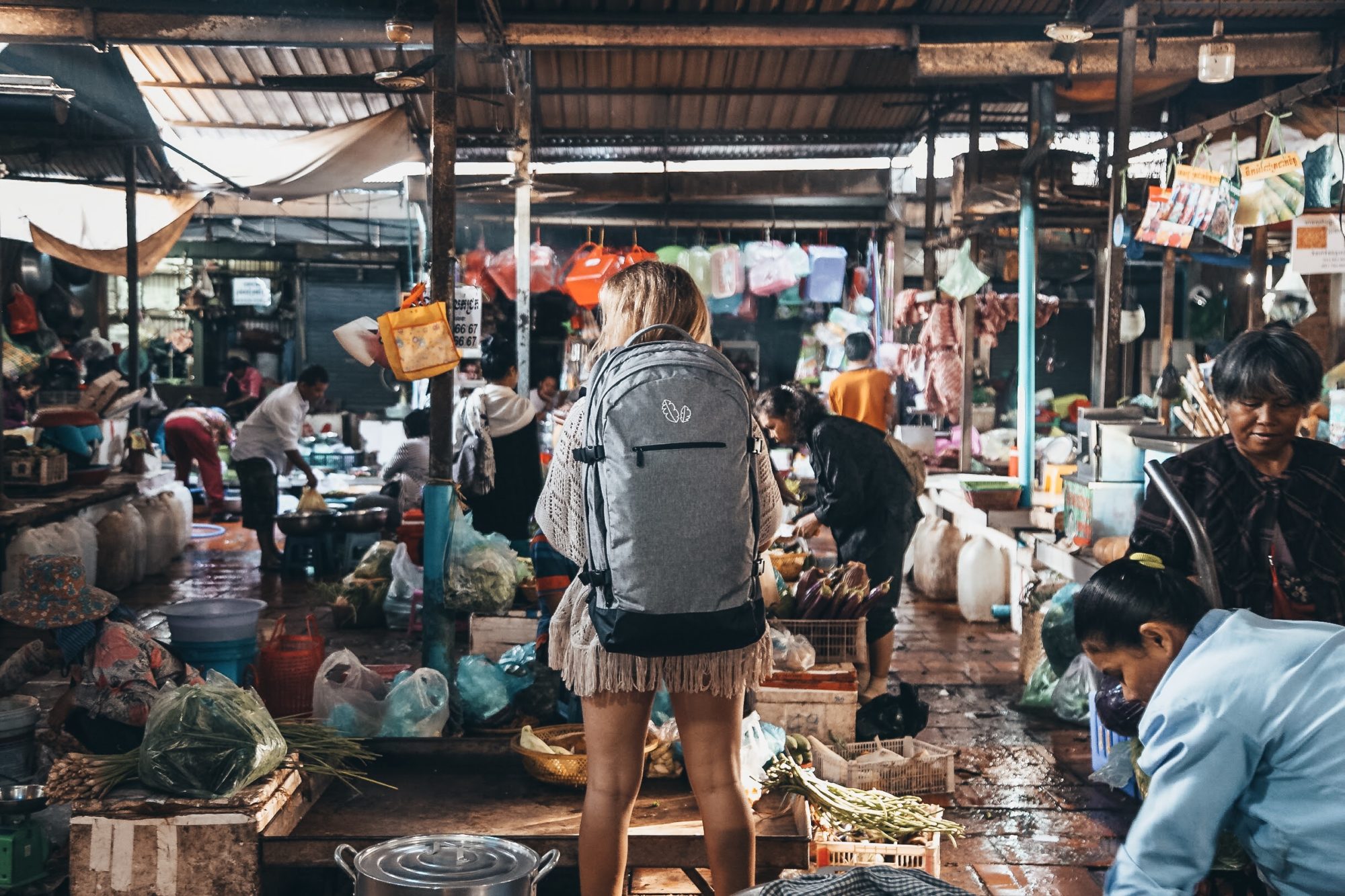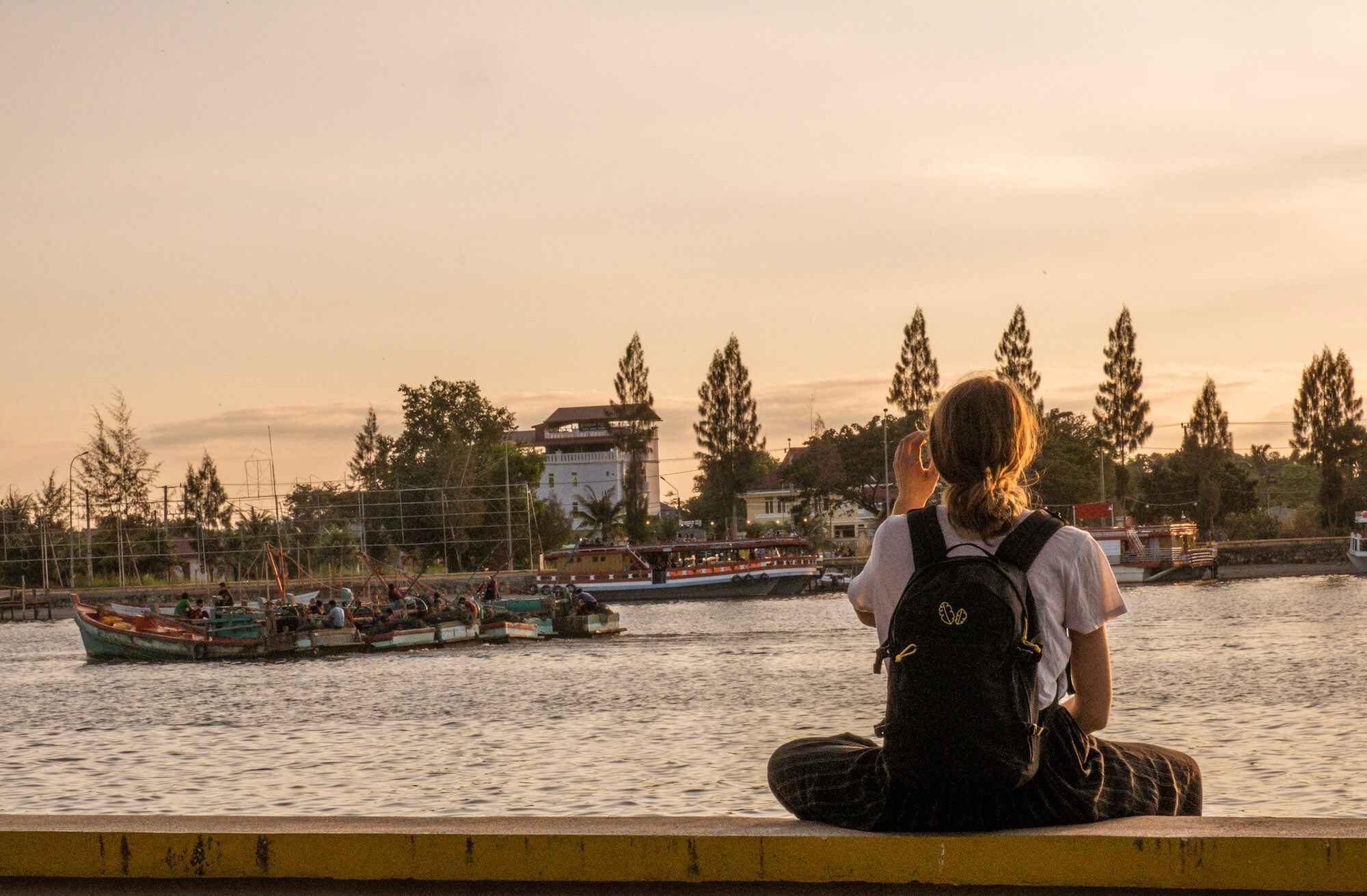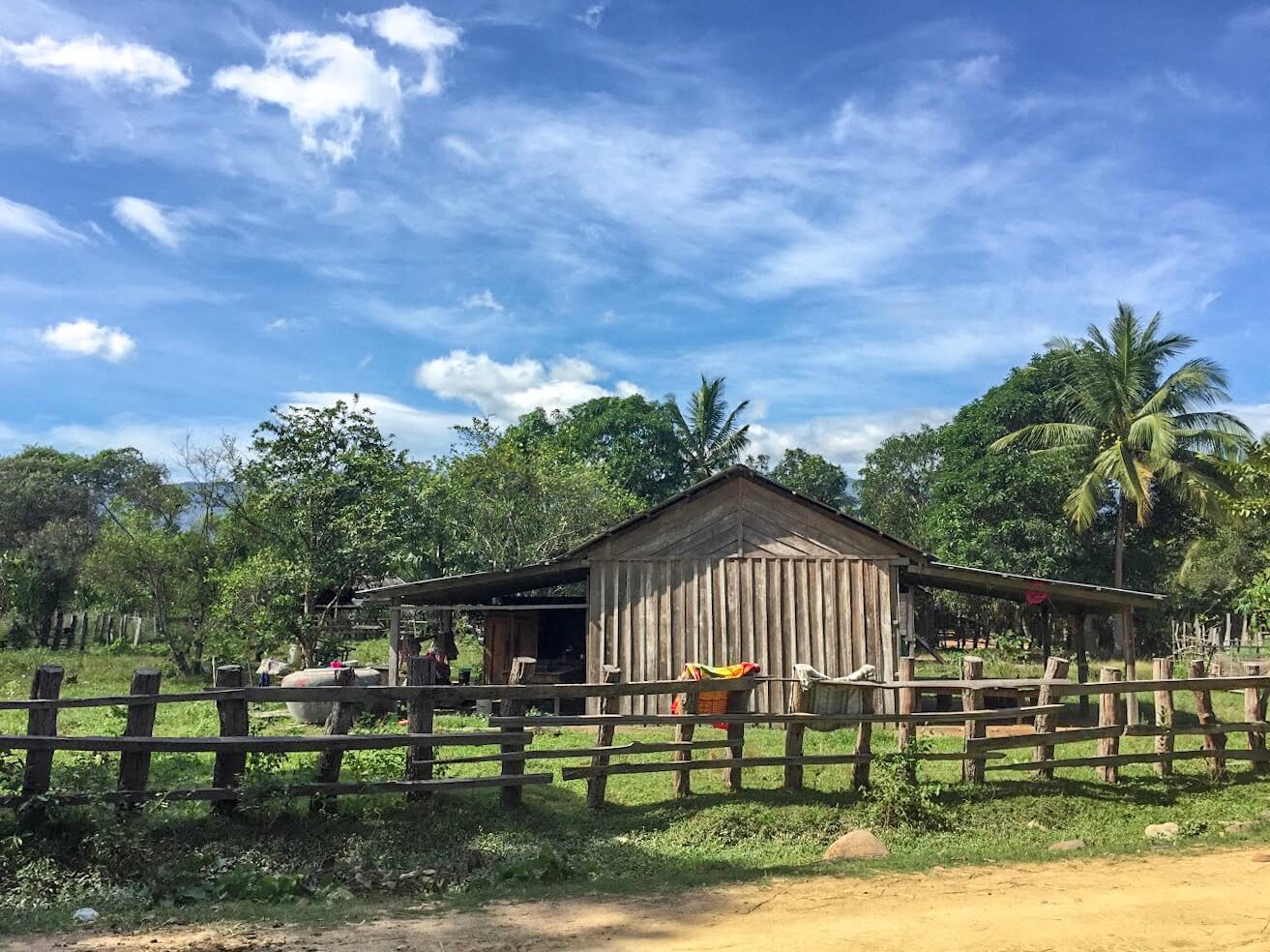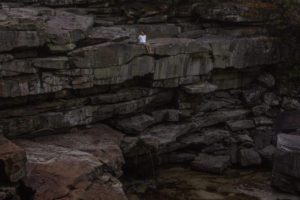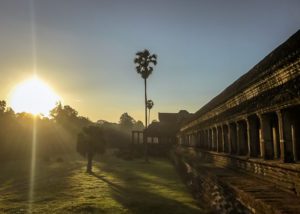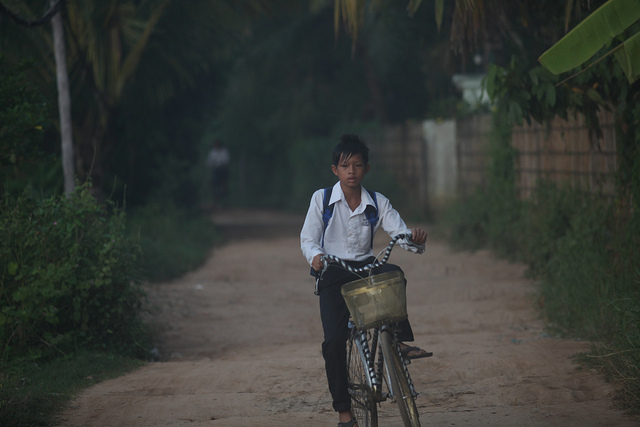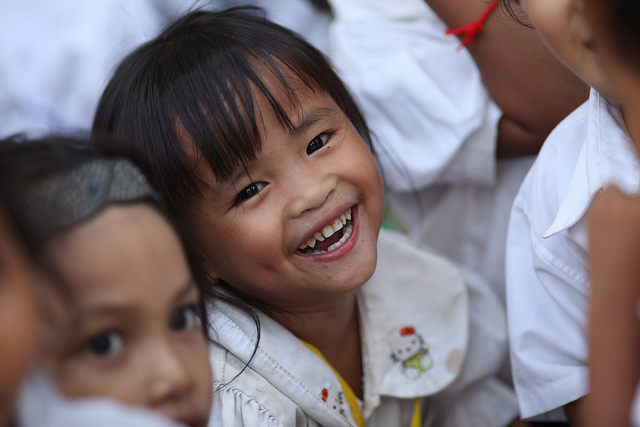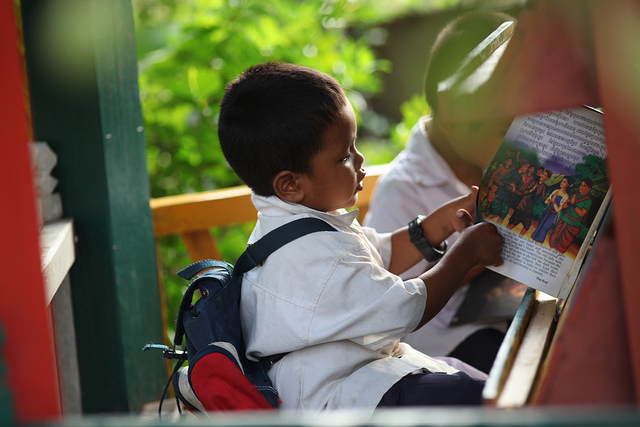If you’re looking for the best things to do on your trip to Cambodia you’ve come to the right place. In this blog post we break down the best 50 things to do in Cambodia and essential additions to any Cambodia Itinerary! From visiting the temples of Angkor Wat to kayaking remote backwaters and acquainting yourself with the country’s fascinating history, the monster list provides all the know how you need for your Cambodian adventure!
**This post contains affiliate links to products or services we know, use and love. If you click one of the links and make a purchase we may earn a small commission at no extra cost to you. These commissions help us continue to improve Tales from the Banana Trail***
What are the best things to do in Siem Reap?
No Cambodia itinerary is complete without a stop in Siem Reap. Conveniently located near the iconic Angkor Archaeological Park, this once sleepy town has come alive in recent years, in some ways for the better and in others for the worse, depending on who you ask.
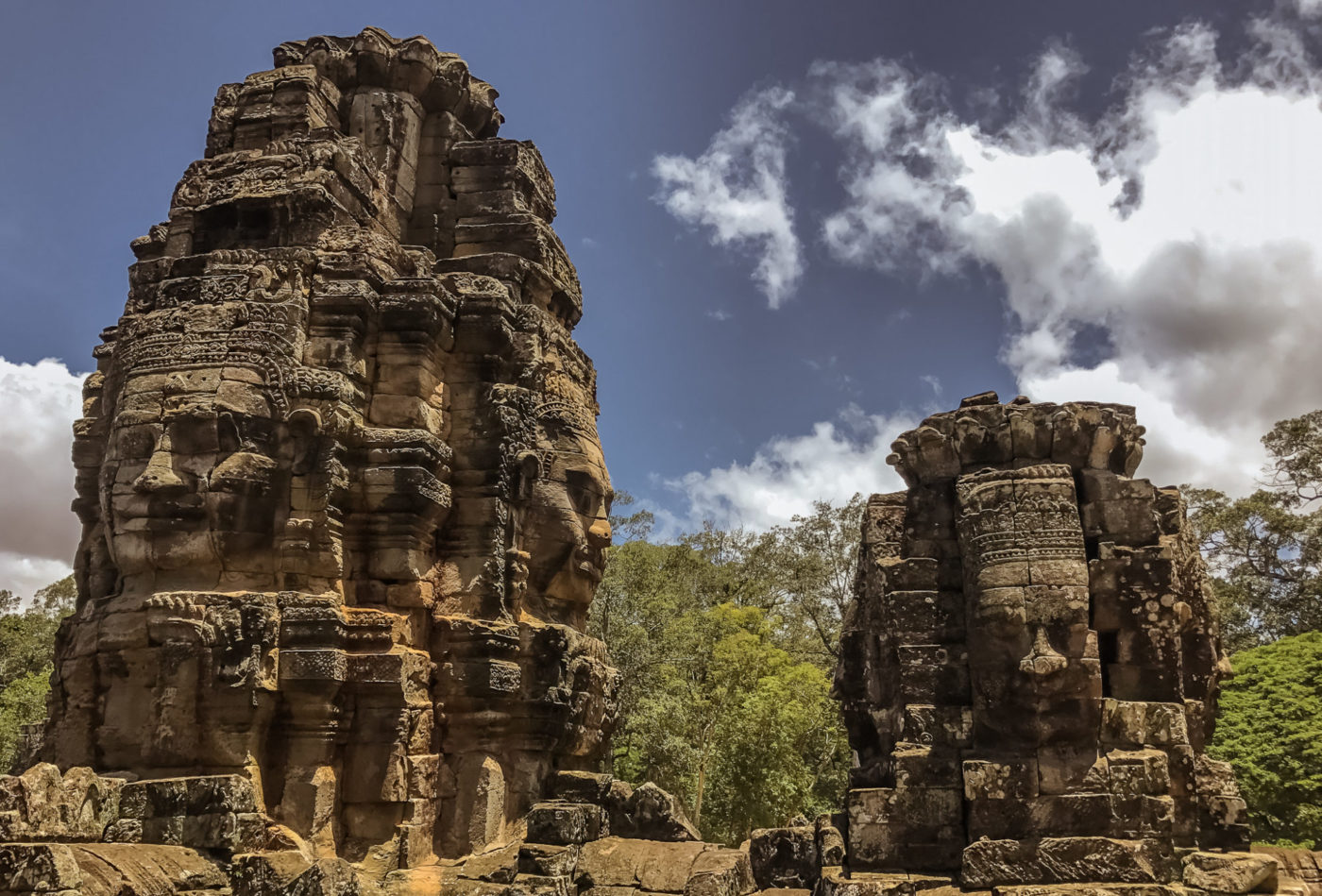
1. Explore the temples of Angkor
No matter your travel experience, age or interest, it is absolutely impossible not to be completely floored by the scale of the majestic temples of Angkor . Witness the sun rise at Angkor Wat or bask in the pre-dawn light as you explore the many levels and courtyards of the world’s largest religious building. Explore the walled city of Angkor Thom by gazing into the 216 faces of Bayon or climb the seemingly endless tiers of the Baphoun. Feel the force of mother nature as giant trees grow from the ancient ruins of Ta Prohm or venture a little further out to the (relative) isolation of Preah Khan’s corridors. With more and more tourists coming every year, the Angkor Archeological Park is a hard place to find much solitude. That said, it’s popular for good reason and finds the top ranking position on any list of things to do in Cambodia. Make sure to check out our comprehensive guide to Angkor to help you plan your time here.
2. Find the “Secret Temples” of Angkor
If the crowds of the Angkor Archaeological Park have you squirming for solitude, fear not! The vastness of the great Khmer empire left many magnificent ruins throughout the country that have (yet) to become cluttered with tuk-tuk drivers and tourists seeking their ultimate sunrise ‘gram. Venture out to Beng Mealea or Banteay Ampil to experience your very own version of Tomb Raider, Indiana Jones, or other bad-ass archaeologist film. Tread lightly though, as just like any good adventure film, there may be a snake or two around. If you want more details, check out this guide we wrote on finding hidden temples.
3. See Phare, The Cambodian Circus
Don’t worry friends, no elephants, tigers, or animals of any kind were harmed in the making of this production! Phare is Cirque Du Soleil meets Cambodian storytelling (historical, folk and modern). Better yet, all of its artists and performers are graduates of a vocational training centre responsible for providing education to poor and at-risk Cambodian youth. Phare, the Cambodian Circus, offers these students and graduates somewhere to hone their skills and a place to earn a wage that will break the cycle of poverty. So go ahead, run away to this circus on your trip to Cambodia!
4. Nourish your stomach and your soul at one of Siem Reap's training restaurants
If you love eating out, Siem Reap may be one of the best places to indulge in Cambodia. Haven, Marum, and Spoons are great options to sample incredible Khmer and international fair. Better yet, every restaurant provides vocational training to all of their staff, allowing them to build the practical and leadership skills to graduate and help shape a bright future for Cambodia. If you want to learn about a few more feel good restaurants, check out this post.
5. Experience the chaos of Siem Reap's Pub Street
The first time we ventured to Siem Reap over a decade ago, Pub Street had already started its evolution into a true backpacker ghetto like Thailand’s infamous Khao San Road or Ho Chi Minh City’s Pham Ngu Lao. For better or for worse, the evolution is now complete. Beer company tank tops are sold on every corner, fast food carts and touts overwhelm the street, and endless throngs of sweaty backpackers stumble around on post-temple pub crawls. If you’re not into the Pub Street party mayhem, it’s still a worthwhile spot to find a table with a view and a cold beer to take in the spectacle.
6. Brunch like a champion
If you’re exhausted from all of the days of temple-ing, or if a night on Pub Street ran you down, brunch may be your best solution. Siem Reap has a few incredible options to brunch to your heart’s content. Enjoy a sunshine smoothie bowl and a flat white at one of our favourite little haunts: Little Red Fox. Take the time to enjoy one of their awesome art sessions that feature local Cambodian artists, musicians, and culture creators. If the night before was rough, or if you just love awesome waffles or waffles meet burgers, head to Missing Socks Laundry Cafe and grab their “signature waffle burger”. They’re also no slouch in the coffee department.
7. Buy local at Angkor Handicraft Association
You can buy “Cambodian” souvenirs all over Siem Reap. Unfortunately the majority of these are manufactured in Thailand, Vietnam or China and do nothing to improve local employment opportunities. Enter Angkor Handicraft Association’s fair trade market, a blissfully relaxed shopping experience where all of the products are certified Cambodian-made. From scarves to clothes to bags, pottery, sculptures and paintings, you’re sure to find your perfect souvenir, all while helping make a difference!
8. Dirt bike Siem Reap’s countryside
If you’re feeling a bit more adventurous, you can go out on a dirt biking trip on the backroads of Siem Reap province. This is a sure way to find completely hidden temples and experience the beautiful rural side of this temple town.
Whatever you do, DON'T FORGET this
When you’re riding motorbikes, taking Tuk-Tuks, or experiencing any of the adventures on this list medical emergencies can happen and you need to be prepared! We had a friend who was medevaced to Bangkok from Cambodia and spent several weeks in the hospital there to the tune of $750,000. Fortunately, she had travel insurance.
If you don’t already have travel insurance, check out World Nomads* . Their coverage includes medical emergencies, luggage & gear and trip cancellation. Hopefully, you never need to make a claim, but if you do you’ll be beyond happy you were prepared!
9. Visit Road 60
Road 60 is the local answer to Pub Street. This road, located just outside of Siem Reap town, turns into a lively spot every night as mats are rolled out onto the pavement, games and rides appear, and there are food stalls galore. If you’re looking to experience a typical Khmer night, this is your spot.
10. Visit Phnom Kulen
Beautiful Kulen mountain is located about two hours from Siem Reap town and it’s a favourite place for Khmer families to take a day trip to on the weekends for a picnic. With incredible waterfalls to see and a cooler climate, this might be just the place to take a breath of fresh and cool air after days of temple exploration.
11. Angkor National Museum
If you’re exhausted from the Cambodian heat, but thirst for more information and artifacts left behind by the Khmer Empire, venture to Siem Reap’s Angkor National Museum. This museum has been at the centre of some controversy, given its for-profit motivation, Thai-ownership, and limited link between many of the buddhas shown and the Angkor-era. That said, you may learn a thing or two and the air conditioning provides much needed reprieve from the Cambodian inferno.
12. Visit the Cambodia Landmine Museum
Cambodia remains one of the most heavily impacted countries by landmines and unexploded ordnance. Recently reopened, the Cambodia Landmine Museum was founded by Aki Ra, a former Khmer Rouge child soldier who has since deactivated thousands of landmines. Your small admission fee supports your own education on the danger of landmines and the education of at-risk and landmine affected youth in neighbouring communities.
13. Get your yoga fix at Peace Cafe
If you’re feeling your legs after all of the temple climbing at Angkor Wat, you might just need to get a good stretch in. Head to Peace Cafe located along the river in Siem Reap for one of their yoga classes. They also offer Khmer language classes.
What are the best things to do in Phnom Penh?


14. Learn about the genocide at Tuol Sleng
Tuol Sleng, otherwise known as Security Prison 21, is a former school that was turned into a security prison during the reign of the Khmer Rouge from 1975-1979. More than 14,000 people were tortured, imprisoned, and ultimately killed in these halls. Only 7 people who walked in here walked out alive. One of these survivors sits at the entry point as you enter S-21. As you navigate past the faces of all those who were lost, it’s a particularly potent reminder of humanity’s dark side. It’s a harrowing place that can’t be missed on a trip to Cambodia to truly understand the country’s history.
15. Travel to the Choeung Ek Killing Fields
Located just 40 minutes outside of Phnom Penh, Choeung Ek was the largest of the Khmer Rouge killing fields. This is the location where those imprisoned and tortured at S-21 were sent to be executed. Today this is a place dedicated to educating both Cambodians and international visitors about the Khmer Rouge genocide in an attempt to prevent this tragedy from ever happening again.
16. Visit the Central, Kandal or BKK Markets
Phnom Penh is bursting with amazing markets to explore, from the famous architecture and fake goods of the Central Market to the souvenir haven of the Russian Market. For really authentic experiences though, visit Kandal or BKK markets when they open at 7am. Watch as shopkeepers lay out vegetables and meat to sell for the day and get lost in the corridors selling the widest range of items. These are the markets not catered to tourists in any capacity and they’re great places to get a sense of Phnom Penh’s daily bustling life.
17. Take a self-guided walking tour from the Royal Palace to the Central Market
After loading up on breakfast (we would suggest nearby ARTillery Cafe), head to the Royal Palace to begin your journey through Phnom Penh’s big sites. Walk past the National Museum, up towards the Central Market and back along the riverside. This map may give you some ideas on how to plan your route.
18. Cycle on Koh Dach (Silk Island)
If Phnom Penh’s concrete jungle tires you out, take a quick local ferry over to Koh Dach (Silk Island). Once you arrive, you can rent a bicycle and leisurely peddle the quiet roads snaking around the island. You can stop and see how silk is made along the way, but the real delight of Koh Dach is its peace and quiet compared to the city next door.
19. Have a drink at the Foreign Correspondents Club (FCC)
Located on the Mekong river, FCC was the gathering place for journalists and aid workers during Cambodia’s civil war and its walls are covered with photographs and stories from these former days. You can feel the history here and it’s a beautiful place to take in the view and relax after a day in the heat.
20. Take a boat trip on the Mekong
Sometimes there’s no nicer way to see a city than from the water, and from a seat. Jump on one of the many boats that head out onto Phnom Penh’s Mekong at sunset to cruise down the waters and enjoy an undisturbed view of the city.
21. Try a Khmer massage, for good
Somewhat lighter than a Thai massage, Khmer massages involve a lot of stretching and kneading. No oil is involved here and you’re given a pajama like outfit to wear. While you can get pretty amazing massages all over Cambodia and often for much cheaper, if you’re in Phnom Penh don’t miss out on One Day Spa. Their training centre provides Cambodian women with the opportunity to develop skills in business management and the hair and beauty industry. Their dark corridors, curtains and warm lighting are reminiscent of stepping into the set of Beauty and the Beast.
22. Go to a free Khmer language class
Looking to learn some of the local language? Head to the Khmer Study Group’s free language meetups held every week in Phnom Penh to pick up a few words, try some delicious food, and maybe meet some new friends.
23. Join in aerobics by the Mekong
Head down to Phnom Penh’s riverside and you’ll be sure to see an outdoor aerobics session in session at some point. Join in to work off some of the Angkor beers you indulged in on Pub Street in Siem Reap. It’s an entertaining experience to say the least.
24. Jump on a trampoline or sip on a coffee at an old factory
25. See the Royal Palace
Still the official royal residence, Phnom Penh’s Royal Palace is nothing short of a grand vision. It’s one of the most popular places to visit in the city, and while it’s worth the trip, what may be nicer is actually sitting on the grass across from the palace where locals gather to feed countless pigeons and snack on their picnics.
26. Take in a rooftop sunset at Juniper Gin Bar
A newcomer to Phnom Penh, the rooftop of Juniper Gin Bar is pretty spectacular. It’s a great way to see the Mekong at night (or watch any celebrations if you happen to be in Cambodia over a holiday – of which there are plenty). The drinks here are also pretty great.
What are the best things to do in Battambang?
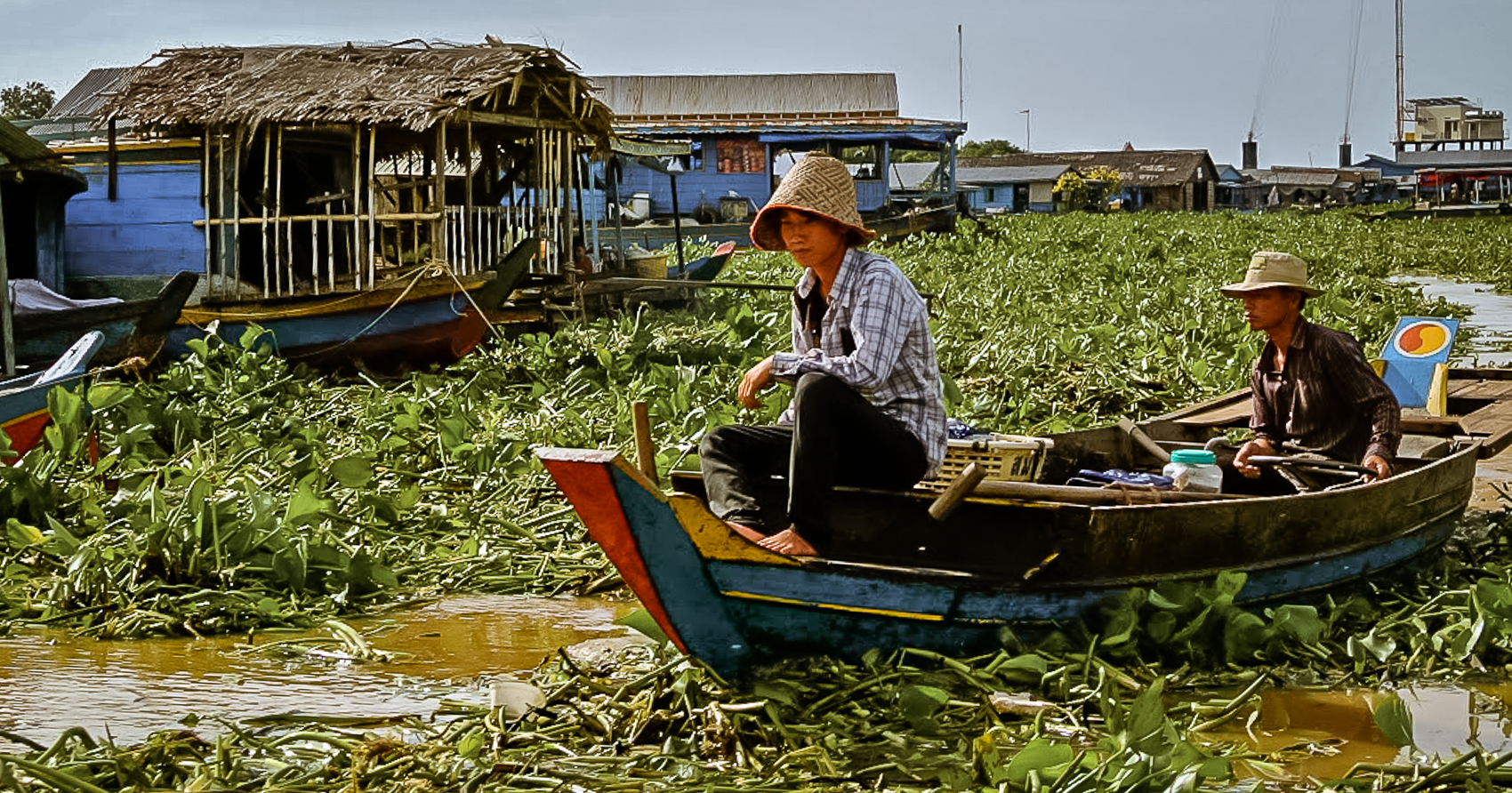


27. Take the slow boat from Siem Reap to Battambang
Sure you could make this trip in one third of the time by bus, but isn’t travel about the journey, not the destination? When the water is low, the boat frequently gets stuck so this can be an extra long journey. While it may be long, it’s far from a boring trip. Passing by villages floating on stilts, local fishermen at work on their boats, and children playing on the riverbanks, this is the way to observe everyday Khmer life at its finest.
28. Learn to cook Khmer style
There is no better place than the sleepy town of Battambang to try your luck at cooking Khmer style. Head over to Nary Kitchen where you’ll scour the local market for ingredients, then return to make multiple dishes you didn’t realize you were capable of creating. A cooking lesson, a delicious meal (we promise Nary’s instructions are foolproof), and a free recipe book thrown in – it is hard to find better value for $10!
What are the best things to do in Kampot
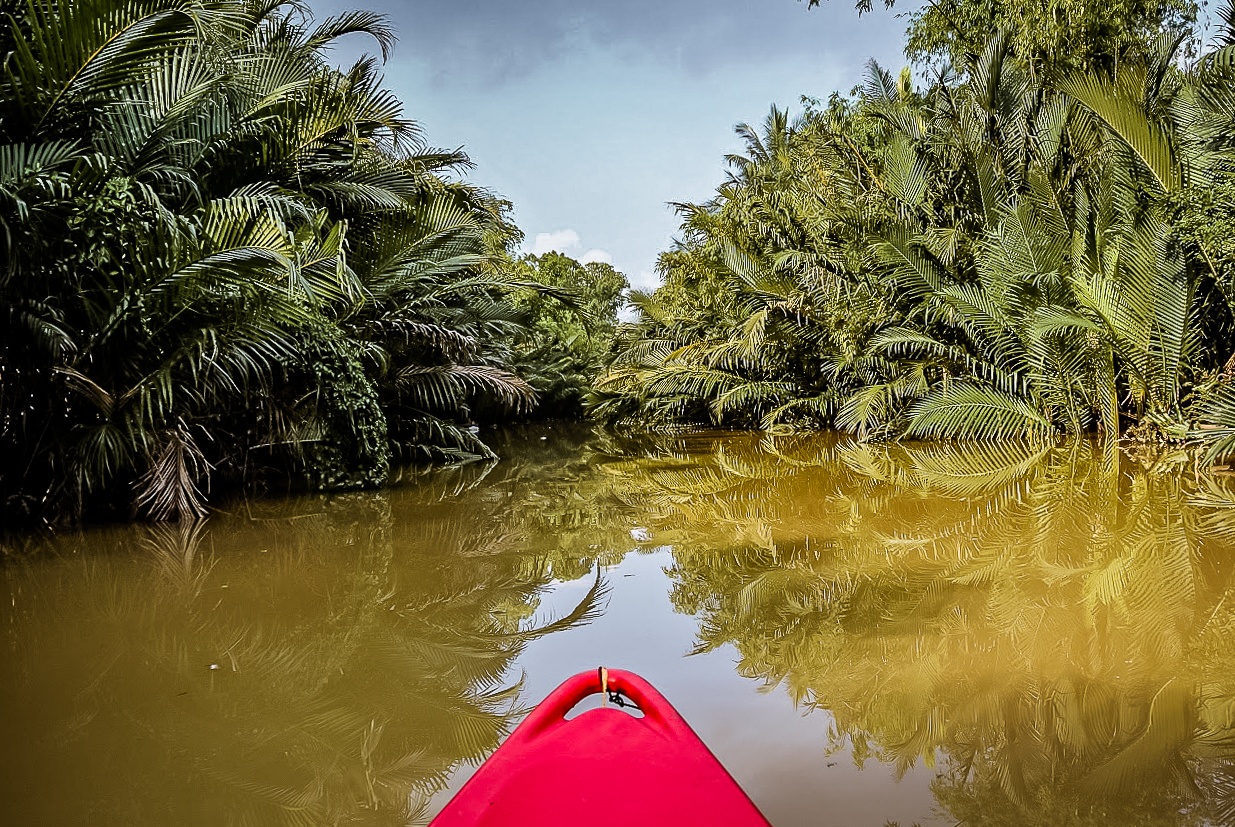


29. Kayak through the Green Cathedral
Picture a Disneyland-style boat ride through the jungle but in real life and you have kayaking the Green Cathedral near Kampot. Rent a kayak at GreenHouse, Champa Lodge or Meraki and explore the beautiful backwaters here that are covered by tree cathedrals. It’s reminiscent of the Mekong Delta and you’ll often have the water completely to yourself. You can also rent a SUP board and test out your balance on the river water.
30. Motorbike up Bokor Hill Station to escape the heat
If you thought cold weather wasn’t possible to find in Cambodia, you need to visit Bokor. A beautiful (and well paved) road winds its way up the mountain into misty air and tree-covered slopes.You’ll be met at the top of the road with waterfalls, buddhas, casinos (old and new), and an old church to explore. It’s chilly on the mountain so you’ll definitely need to bring a sweater.
31. Take a tour of a pepper farm
Even if you’re not a self-professed pepper person, a visit to Kampot’s incredible pepper farms is not one to be missed. Head out to the beautiful La Plantation for a free tour of the farm, how pepper is made, and a tasting of all different types of pepper. Kampot pepper is famous internationally and it was actually the first Cambodian agricultural product to be granted protected geographical indication status.
32. Cycle past the salt fields
Less famous than its pepper, the salt fields surrounding Kampot are no less beautiful to see. Hop on a bicycle and head out of town to take a leisurely cycle past the white fields. It’s a beautiful way to see the Khmer countryside.
Check out our guide 20 Incredible Things To Do In Kampot for more ideas for your trip to Kampot!!
What are the best things to do in Kep?
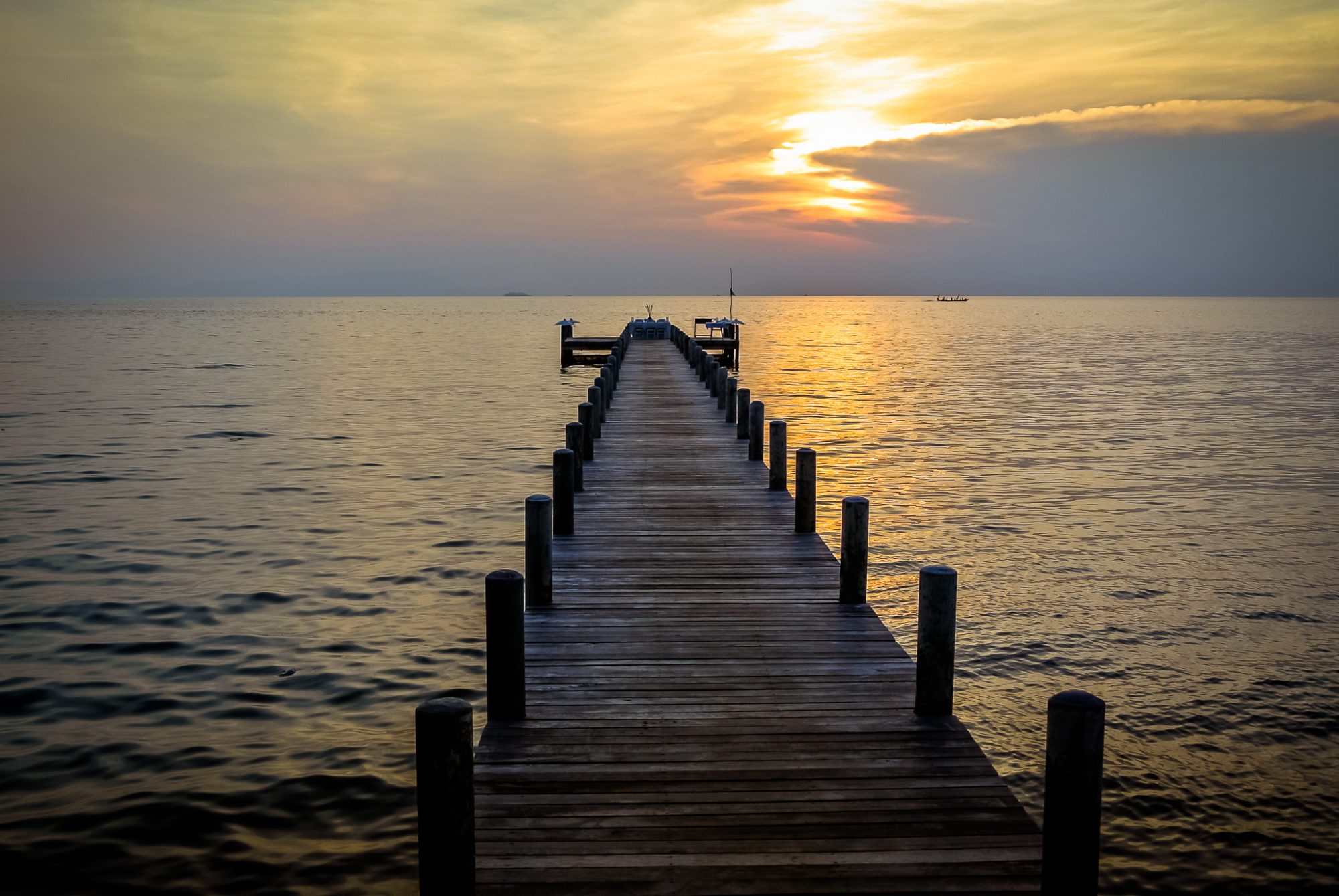


33. Take in a sunset at Kep’s Sailing Club
Kep’s swanky Sailing Club on the beach is a great place to grab a sunset drink and take in the incredible view over the ocean. It’s not cheap, but it’s also not as expensive as you might think when you first see its location. Their fresh fish is delicious if you’re looking to extend your restaurant stay.
34. Sea kayak or paddleboard in Kep
From Kep’s Sailing Club you can rent sea kayaks and paddleboards to explore the waters around. It’s a great way to get some great exercise and see Kep’s beautiful coastline from the water.
35. Pull out your hiking shoes in Kep National Park
Kep National Park is one of the only places where you can hike without a guide in Cambodia, as the area has been completely cleared of landmines and unexploded ordnance. A trail system snakes around the park and it’s a great place to take a two hour stroll or peddle a mountain bike through. You’re sure to see an animal (or ten) here. The Led Zep Cafe makes for a nice spot to rest your feet and quench your thirst in the park.
36. Fulfill your Castaway dreams on Rabbit Island
Koh Tonsay (or Rabbit Island) is a blissful little patch of sand less than an hour by boat from Kep. It’s certainly rustic and if you’re looking for a Castaway experience, you can settle into one of the little bungalows on the beach here to stay the night.
What are the best things things to do in Cambodia’s mountains
37. Go on an ethical elephant encounter
Cambodia’s wild eastern province of Mondulkiri is home to a range of opportunities to see elephants. Emphasis on seeing, not riding. Be sure to read this thoughtful article to make an informed decision about which elephant sanctuary you visit. They aren’t all created equally and it’s important to choose a place that doesn’t add any additional stress to these animals lives.
38. Go trekking in Mondulkiri or Ratanakiri
Cambodia’s wild east is full of unexplored territory to be found. To get a feel for this, take a multi-day jungle trek through Mondulkiri or Ratanakiri provinces. In the rainy season you may just find a waterfall or two to explore.
P.S. Check out our guide on what to do in Mondulkiri.
39. Visit Heaven Cliff in the Cardamom mountains
Located in Cambodia’s Cardamom mountains, Kirirom National Park is an oasis of forests, waterfalls and, you guessed it, cliffs. Jutting out like Pride Rock over a valley of trees, Heaven Cliff offers incredible views over the Cardamoms. It’s an easy hike in to access the cliff and it’s worth the small bit of exercise to see this incredible view.
What are the best things things to do on Cambodia’s islands
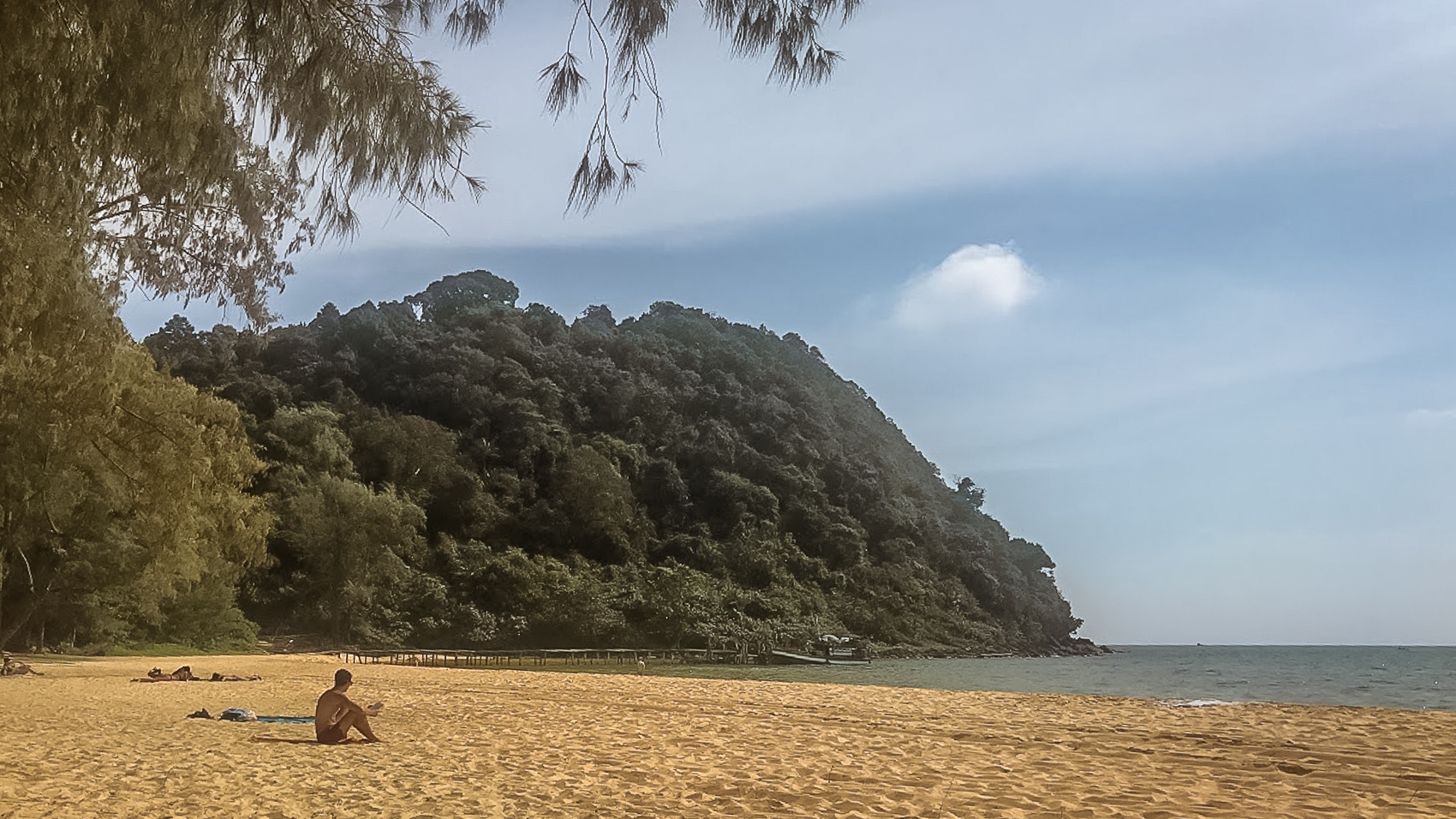


40. Bask in the sun on sleepy Koh Ta Kiev
Koh Ta Kiev is still reminiscent of Cambodia’s islands a decade ago. A quick ferry ride from Sihanoukville takes you to this sleepy place where you can hang out in the sun, take advantage of the perks of solar power and curl up in Kactus’ treehouses.
41. Explore underwater
Cambodia’s islands are home to several great dive sites. Koh Rong, Koh Rong Sanloem, Koh Kong and Koh Tang all offer incredible underwater sights from seahorses to barracuda to incredible coral.
42. Join the party on Koh Rong
Gone are the days when Koh Rong was still a whisper on backpackers’ itineraries through Southeast Asia. It’s now a well-trodden party spot (depending on the part of the island you visit). It may not be on par with Koh Phangan’s many different moon parties, but it’s still the spot to go if you’re looking to liven things up in Cambodia.
43. See the bioluminescent plankton light up at night
If you’ve watched The Beach, you’ve probably already dreamt of swimming in an ocean lit up by plankton sometime in your life. While swimming in the ocean waters at night may not be the safest choice, you can take a boat out to see this phenomenon when you visit Cambodia’s islands. Head out at night into the water and get lost in the blue light as the bioluminescent plankton comes to life with your movements.
A few more amazing things to do in Cambodia
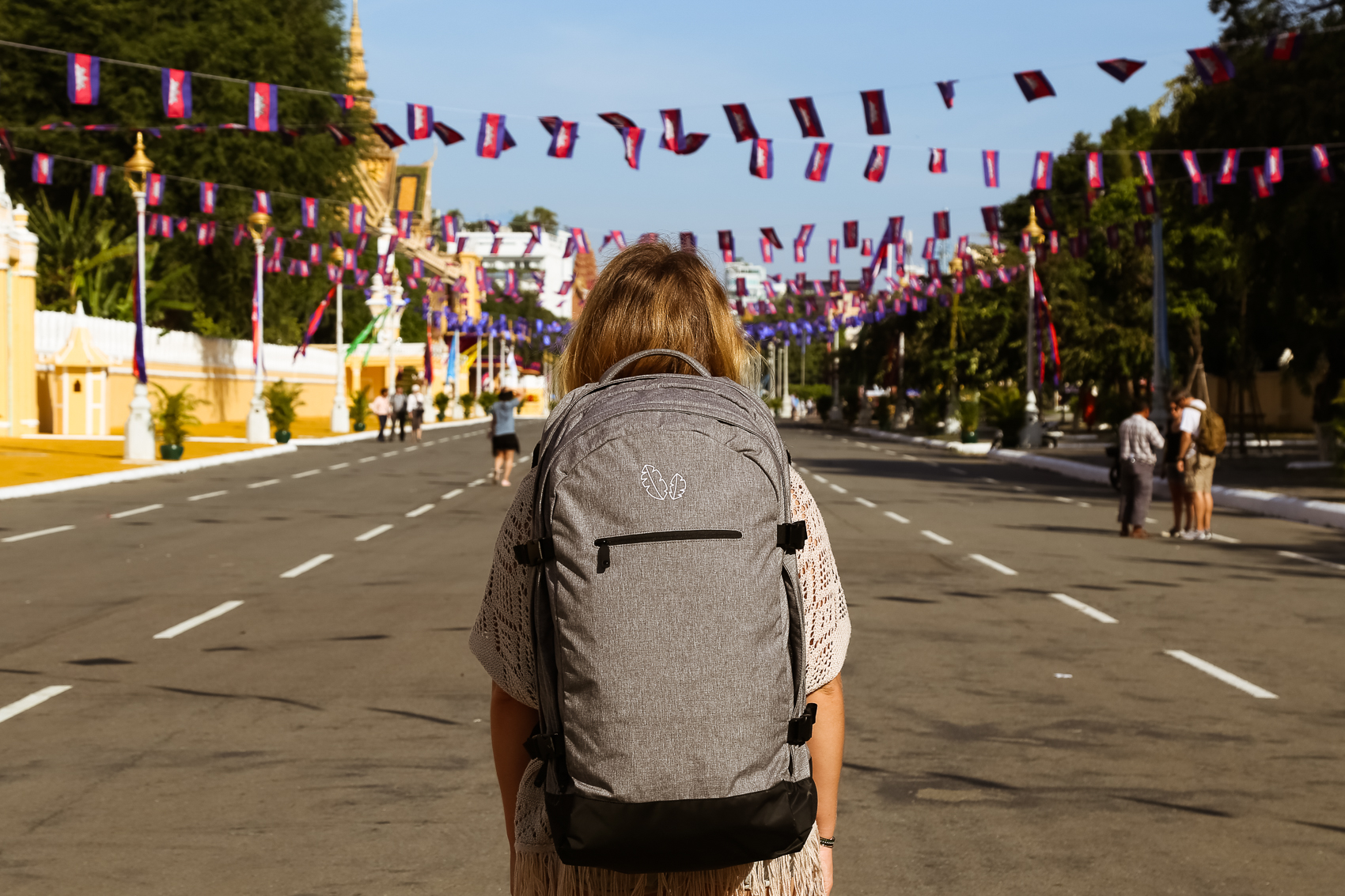


44. Try a tarantula or cricket
Cambodia is famously known for its roadside tarantula and cricket snacks. You often find these offered at local markets across the country and if you aren’t too scared to give them a try, you may just find them to be your new favourite snack.
45. Kayak to see the dolphins in Kratie
Cambodia’s rare Irrawaddy dolphins are found in the river near the dusty town of Kratie. The unique, short beaked creatures draw quite a crowd. The best way to see them is through a kayaking trip that takes you past riverside villages and ideally the dolphins, without disrupting them by taking a motorboat.
46. Try out meditation for a day or ten… at Wat Langka or a Vipassana course
Phnom Penh’s centrally located Wat Langka offers one-hour free meditation sessions multiple times a week. If you’re looking for a taste of meditation this may be for you. If you’re a veteran and looking to take it to the next level, try one of the international Vipassana ten day silent retreats in Cambodia to take your mind to the next level.
47. Visit the ever-political Preah Vihear
The views here are almost as impressive as the temple itself. Perched on top of a 525m mountain, Preah Vihear has been the source of tension between Cambodia and Thailand over the years, as both vie for its ownership. It’s located 200km from Siem Reap so you’ll definitely need more than a day to get here and fully explore the temple’s four levels and courtyards, but this is a place more than worth the detour.
48. Go to an Apsara dance show
Apsara is Cambodia’s most popular form of classical dance, dating back to the 7th century. The hand movements in Apsara are nothing short of incredible. A number of shows are held at different venues around the country, but the most famous is held at the National Museum in Phnom Penh every night by Cambodian Living Arts.
49. Try Cambodia’s favourite snack
As soon as you make your first Khmer friend, you’re sure to be offered this snack: green mango with prahok (fermented fish paste) or chili dip. In Cambodia eating sour green fruits, especially green mango, with prahok or chilis is very common. It has a different taste but quickly grows on you.
50. Visit one of Cambodia’s community-based tourism initiatives
Offering a great way to experience traditional Cambodian life and benefit community development, ecotourism and community-based tourism are ever-growing in Cambodia. One of the most famous places for this is Chambok, located near Kirirom National Park. This site was set up in 2002 under the support of a local NGO to provide alternative livelihoods to community members and protect the surrounding areas from deforestation. Stay in a homestay here and experience incredible trekking and swimming in the waterfall nearby.
More Posts on Cambodia
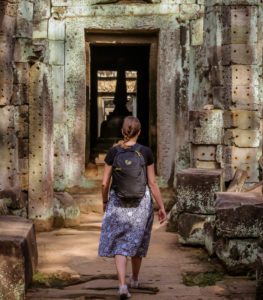

Angkor Wat Guide – Plan Your Visit to the Temples of Angkor [2023]
Which temples do you need to see at Angkor? How many days does it take to visit them all? What’s the best way to get around? Plan your trip to the temples of Angkor with this comprehensive guide.
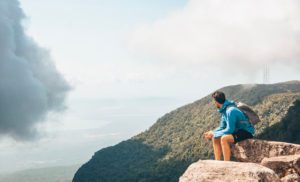


Cambodia’s Best Motorbike Trips | 3 Incredible Adventures in the Kingdom of Wonder
From hidden temples to deserted hill stations, Cambodia is the perfect country to go on a motorbike adventure. Here are 3 of the best!
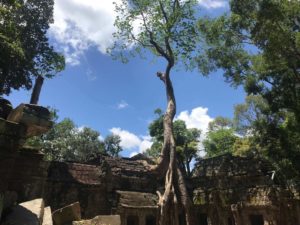

The 5 Best Cambodia Itineraries | Plan the Perfect Cambodia Trip
After living and exploring Cambodia for years, I’ve put together this robust travel guide and itinerary planner. If you’re planning a trip to Cambodia and mapping out the perfect Cambodia itinerary there’s something in the post for you!

